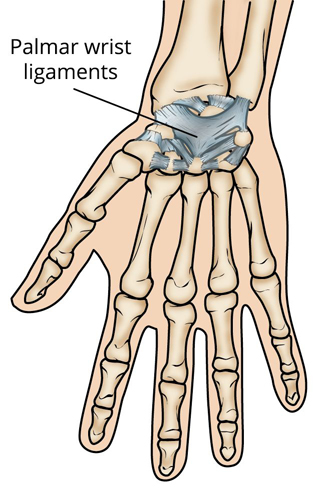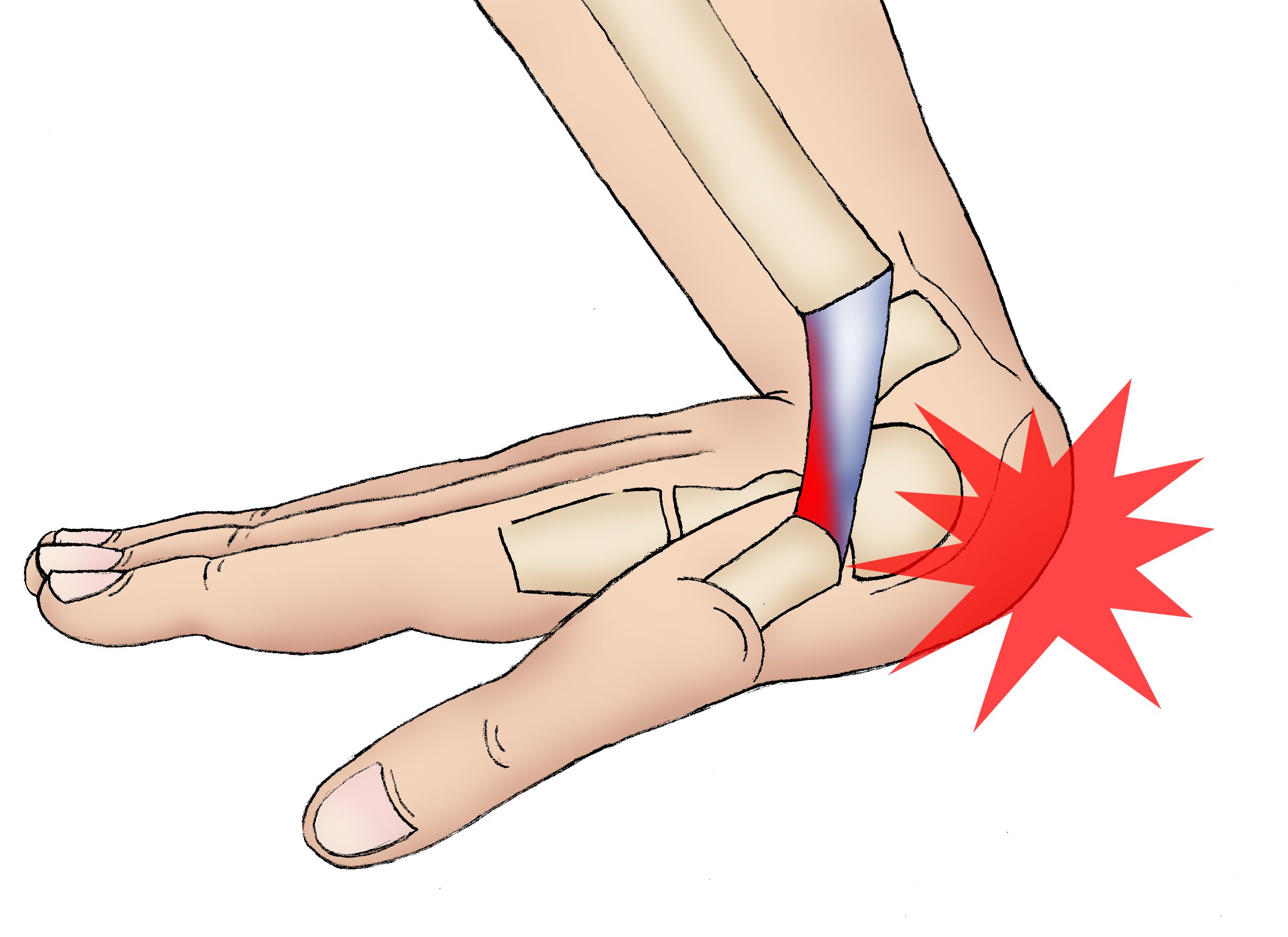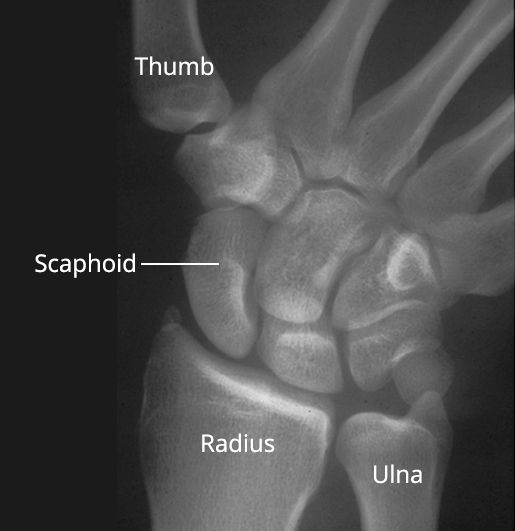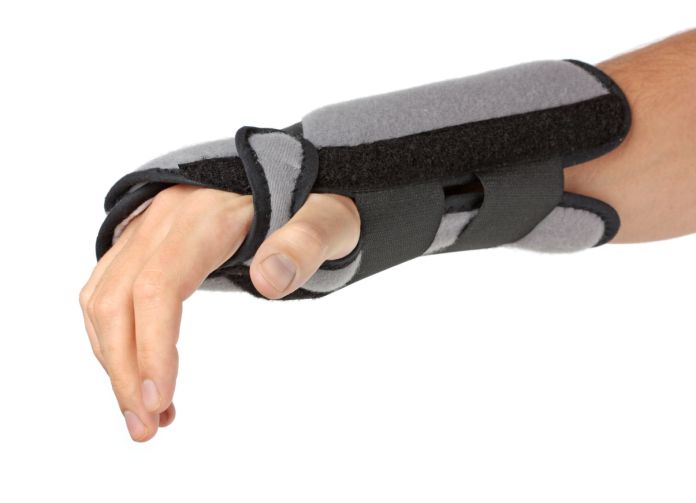Diseases & Conditions
Wrist Sprains
Wrist sprains are common injuries that occur when the wrist is bent or twisted forcefully. When this happens, the strong ligaments that support the wrist can stretch beyond their limits or tear.
Wrist sprains are typically caused by a traumatic event, such as a fall onto an outstretched hand. They can range from mild to severe, depending on how much damage there is to the ligaments.
This article focuses on wrist sprains. To learn more about wrist fractures, see Scaphoid Fracture of the Wrist, Distal Radius Fractures (Broken Wrist), or Hook of the Hamate Fracture of the Wrist.
Description
Ligaments are strong, fibrous tissues that connect bones to other bones. The ligaments in the wrist help to keep the bones of the wrist in proper position and stabilize the joint.
The wrist joint is made up of the radius, the ulna, and eight smaller carpal bones. This complex system relies heavily on ligaments for stability. Thus, injuries to these ligaments can result in pain and dysfunction of the wrist.
Sprains can range from a stretch or tiny tear in the fibers that make up the ligament to a complete tear through the ligament or through its attachment to the bone. Typically, higher grade/worse injuries require more advanced treatment and more time to recover.
Grades of Wrist Sprains
Sprains are graded based on the degree of injury to the ligaments:
- Grade 1 sprain (mild). The ligaments are stretched but not torn.
- Grade 2 sprain (moderate). The ligaments are partially torn. This type of injury may involve some loss of function.
- Grade 3 sprain (severe). The ligament is completely torn, or the ligament is pulled off of its attachment to bone. These are significant injuries that may require more advanced medical or surgical care. If the ligament tears away from the bone, it may take a small chip of bone with it. This is called an avulsion fracture.
Cause
A variety of traumatic events can cause a wrist sprain. They are most often caused by a fall onto an outstretched hand. This might happen during everyday activities, but it most frequently occurs during sports and outdoor recreational activities.
Symptoms
A sprained wrist is typically painful. Other symptoms may include:
- Swelling
- Bruising
- Tenderness to touch
- A feeling of popping or tearing inside the wrist
- A feeling of warmth around the wrist
Even a wrist injury that seems mild with minimal swelling could still involve a torn ligament and may even require surgery to avoid long-term problems.
Similarly, an unrecognized (occult) fracture can be mistaken for a mild or moderate sprain. If left untreated, the fracture may not heal properly, and you could require a surgical procedure that might have been avoided with early, appropriate treatment. The most common example of this is an occult fracture of the scaphoid, one of the small bones in the wrist.
Thus, it is important for your doctor to evaluate even a mild wrist injury if it does not improve quickly. This is especially important if the injury causes persistent wrist pain (pain that does not go away). Proper diagnosis and treatment of wrist injuries is necessary to avoid long-term problems, including chronic pain, stiffness, and arthritis.
Doctor Examination
Physical Examination
After discussing your medical history and general health, your doctor will:
- Likely ask about any previous injuries to your hand or wrist.
- Ask how and when your current injury occurred.
- Ask you to describe your symptoms, including whether you have any numbness in your hand or pain in any other locations.
- Carefully examine your wrist to see where it hurts and to check how it moves. Tenderness in certain areas may also be consistent with a broken bone or torn ligament.
- Possibly examine your entire hand and arm to make sure you have no other injuries.
Imaging Tests
Your doctor may order imaging tests to help confirm the diagnosis.
X-rays. Although an X-ray will not show the ligaments themselves, if an X-ray shows that the wrist bones do not line up correctly, this can be a sign of a ligament injury. An X-ray can also help your doctor see if there is a broken bone in your wrist.
Other imaging tests. If more information is needed, your doctor may order a magnetic resonance imaging (MRI) scan, computerized tomography (CT) scan, or arthrogram.
In an arthrogram, a special dye is injected into the wrist joint. This makes the joint and ligaments show up more clearly on an imaging study.
Treatment
Treatment for a wrist sprain depends on the severity of the injury.
Home Care
Mild wrist sprains will usually improve with home treatment that includes the RICE protocol:
- Rest. Avoid strenuous activities that aggravate the strain.
- Ice. Apply ice immediately after the injury to keep the swelling down. Use cold packs for 20 minutes at a time, several times a day. Do not apply ice directly on the skin; use an ice pack or bag, or wrap the ice in a towel or cloth.
- Compression. Wear an elastic compression bandage to reduce swelling. Do not apply the bandage too tightly, as this can be harmful.
- Elevation. As often as possible, rest with your wrist raised up higher than your heart to reduce swelling.
Additionally, nonsteroidal anti-inflammatory drugs (NSAIDs), such as naproxen or ibuprofen, can help reduce pain and swelling. However, if pain and swelling persist for more than 48 hours (2 full days), see a doctor.
Nonsurgical Treatment
Moderate sprains may need to be immobilized with a wrist splint.
Because immobilization may cause some stiffness in your wrist, your doctor may recommend some stretching exercises to help you regain full mobility.
Formal therapy can be quite helpful when recovering from a significant wrist sprain.
Surgical Treatment
Severe sprains may require surgery to repair the fully torn ligament. Surgery involves reconnecting the ligament to the bone or using a tendon graft to reconstruct the injured ligament. Your doctor will talk with you about which option is best in your situation.
After surgery, there will be a period of rehabilitation that includes immobilization, followed by exercises to strengthen your wrist and restore range of motion.
Although the ligament usually heals in 8 to 12 weeks, it can take 6 to 12 months for a full recovery. The length of the recovery process and your outcomes will depend on the severity of the sprain/tear.
Outcomes
The ultimate outcome of a wrist sprain is highly variable.
- Mild wrist sprains often result in a full recovery over several weeks.
- Moderate sprains may take longer to recover from and may require surgical intervention in those patients who do not recover well.
- Severe sprains/tears may require surgery to achieve a reasonable outcome.
- In some patients with severe sprains/tears, even surgery cannot fully restore wrist function. This depends on the type of tear, age of the patient, and timing from injury to surgery. For this reason, it is important to seek care rapidly if you suspect that you have a serious injury to your wrist.
Some patients with severe sprains/tears who either do not seek treatment or do not have a successful outcome following treatment will develop arthritis of the wrist in the long term. This often will take several years to develop. If it does develop, further treatment may be necessary. Please see the article on wrist arthritis for more details.
Prevention
Because wrist sprains usually result from a fall, be careful when:
- Walking in wet or slippery conditions
- Going up and down stairs or hills
- Stepping down off of curbs
- Walking on uneven or unstable surfaces (e.g., brick or cobblestone streets, grass, and pavement with a lot of cracks or missing pieces)
- Walking a dog; never wrap the leash around your hand or wrist
Wrist sprains also occur during sports, such as skating, skateboarding, and skiing. Wearing wrist guards or protective tape when participating in these activities will help support your wrist and can prevent it from bending too far backward if you fall.
Contributed and/or Updated by
Peer-Reviewed by
AAOS does not endorse any treatments, procedures, products, or physicians referenced herein. This information is provided as an educational service and is not intended to serve as medical advice. Anyone seeking specific orthopaedic advice or assistance should consult his or her orthopaedic surgeon, or locate one in your area through the AAOS Find an Orthopaedist program on this website.










